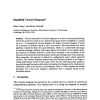Free Online Productivity Tools
i2Speak
i2Symbol
i2OCR
iTex2Img
iWeb2Print
iWeb2Shot
i2Type
iPdf2Split
iPdf2Merge
i2Bopomofo
i2Arabic
i2Style
i2Image
i2PDF
iLatex2Rtf
Sci2ools
COMPGEOM
1987
ACM
1987
ACM
Simplified Voronoi Diagrams
We are interested in Voronoi diagrams as a tool in robot path planning, where the search for a path in an r-dimensional space may be simplified to a search on an (r- l)-dimensional Voronoi diagram. We define a Voronoi diagram V based on a measure of distance which is not a true metric. This formulation has lower algebraic complexity than the usual definition, which is a considerable advantage in motion-planning problems with many degrees of freedom. In its simplest form, the measure of distance between a point and a polytopc is the maximum of the distances of the point from the half-spaces which pass through faces of the polytope. More generally, the measure is defined in configuration spaces which represent rotation. The Voronoi diagram defined using this distance measure is no longer a strong deformation retract of free space, but it has the following useful property: any path through free space which starts and ends on the diagram can be continuously deformed so that it lies entirel...
COMPGEOM 1987 | Discrete Geometry | L)-dimensional Voronoi Diagram | Lower Algebraic Complexity | Voronoi Diagram |
| Added | 28 Aug 2010 |
| Updated | 28 Aug 2010 |
| Type | Conference |
| Year | 1987 |
| Where | COMPGEOM |
| Authors | John F. Canny, Bruce Randall Donald |
Comments (0)

